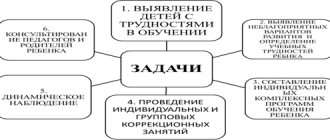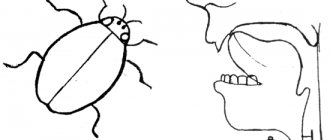Etc.
Graphic abbreviations adopted in the Russian language are numerous and varied. Graphic abbreviations are used in scientific and popular science literature, in dictionaries and bibliographic lists, in cartography and in private correspondence. Students of the Russian language will encounter abbreviated words both when reading textbooks, newspapers, notes and letters, and on the street, in an office, in transport and at the stadium.
Even a trained native speaker cannot always decipher this or that abbreviation that he comes across, so the attention of Russian language learners should be paid to abbreviations that have practical, communicative significance and are used every day and everywhere. These graphic abbreviations include:
1.
Designations of grammatical categories and concepts in textbooks and dictionaries:
m.r.
(masculine),
units.
h. (singular),
pr. v.
(past tense)
2nd l.
(second person),
ch.
(verb),
noun
(noun),
suff.
(suffix) ...
2.
Designations of units of measurement (without affecting terminology and accepted abbreviations in specialized and scientific literature):
- Weights: g
(gram),
kg
(kilogram); - Time: min
(minute),
h
(hour),
g
(year); - Pressure: mm.
rt. Art. (millimeters of mercury),
atm.
(atmosphere); - Distances, areas, volumes: km
(kilometer),
ha
(hectare),
l
(liter); - Information: b
(byte),
GB
(gigabyte); - Coordinates: s.
w. (north latitude),
c.
d. (eastern longitude); - Quantities: thousand
(thousand),
million
(million),
billion
(billion),
units.
(unit);
3.
Names of monetary units:
r., rub
.
(ruble), dollars
(dollar),
shek.
(shekel),
y.
e. (conventional unit)
4.
Toponymic designations on maps and diagrams:
st.
(street),
pl.
(area),
st.
m. (metro station),
ave.
(prospect),
r.
(river),
city
(city, mountain)
5.
Common abbreviations designed to save time and space and speed up writing:
so-called
- so-called;
i.e.
– that is;
since
- since;
That.
- Thus;
see
- look;
page
– page;
BC
e. - BC;
railway
– railway;
used
– used;
And.
O. – acting;
and others
- and others;
people
- a person,
and
so
on
, and
so
on .
There are rules and standards governing the spelling of graphic abbreviations, the presence or absence of periods, commas, spaces in the abbreviation used, and the addition of endings to numerals. It seems appropriate to invite students to study these rules as the need arises.
comments addressed to someone - comments addressed to someone
(in this combination, the first option has a colloquial character; in the meaning “in relation to someone” in book speech the combination
at address
; cf. Gorky:
Varvara Ivanovna got angry and uttered a few words at me...
; Kuprin:
I ask without hints at my address...
);
in excitement
(full coverage of feeling) -
with excitement
(partial coverage);
with freckles - with freckles, with patches - with patches
(in the first combination of each pair the completeness of coverage by the feature is indicated, in the second - the attribute’s belonging to the subject);
speaks for that - speaks for that
(the first option has a colloquial character; cf. Chekhov as a stylistic device:
Every movement of his soul speaks for the fact that in my client I have the honor of seeing an ideal person
- from the speech of a provincial lawyer);
signed and sealed – signed and sealed
(the first option is inherent in the official business style);
in confirmation - for confirmation
(the first combination is characteristic of a bookish-business style, the second - neutral);
to ingratiate oneself with someone - to ingratiate oneself with someone
(the first option is outdated);
go for mushrooms - go for mushrooms, go for water - go for water
(the first options in each pair are colloquial in nature);
for fear of not doing - for fear of not doing
(the first option indicates a conscious nature, the second contains an indication only of the reason);
in a car accident - in a car accident
(the first option indicates the immediate cause, the second – the setting of the event);
have not been erased from memory - have not been erased from memory
(the second option is more common; cf.:
The affectionate tone of these words will never be erased from my memory
(Kuprin);
to shreds - to shreds
(the first combination means “tear into small pieces that cannot be counted”, the second - “tear into pieces that cannot be counted”);
a dispute broke out between them - a dispute broke out between them
(the first combination indicates the environment in which the action was performed, the second - the participants in this action);
shoot at the enemy - shoot at the enemy
(in the first combination the direction of action on the object is indicated, in the second - the distribution of action on a number of persons);
to walk about a kilometer - to walk about a kilometer, it will take about a month - it will take about a month, there are about a hundred children - there are up to a hundred children
(the second option in each pair is conversational in nature);
this role is for me - this role is for me, what do you need these things for - what do you need these things for
(the first option in each pair is neutral, the second is conversational);
almost died of hunger - almost died of hunger
(the first option is used in everyday speech);
use for local needs - use for local needs, measures for implementation - measures for implementation
(in the first pair the preposition
on
, in the second the preposition
for
brings a greater connotation of purposefulness);
lectures on announced topics – lectures on all ten announced topics
(in the second option the meaning of generalization);
observations of stars, radio emissions - observations of experimental animals
(the difference is due to the meaning of the controlled words: when it is possible to intervene in the observed phenomenon, to regulate it, a construction with the preposition
over
);
with the help of technology - with the help of friends
(the second option specifies the character);
in order to implement - in order to implement
(the first construction is associated with an infinitive, the second - with a verbal noun, mainly in business speech);
table with three legs - a table with three legs
(the first option is outdated).
In some cases, established word usage and proximity to phraseological units are reflected, for example: to the best of one’s ability and ability - as needed, to be in service - to be in service, to roll with laughter - to roll with laughter
.
The clerical character of the statement is given by the currently widespread use of the preposition according to
instead of other prepositions;
Wed examples from periodicals: “The delegation received answers to
questions
of interest to it ” (instead:
... to questions
);
“...the only response
of a critic
to this work
" (instead:
...to this work
);
“Russian exports covered most of
Holland’s
needs for
rye, barley, wheat, lumber, manganese ore, etc.”
(instead of: ...needs for...
);
“There was a competition for the best song
(instead of:
...for the best song...
).
The use of some prepositions instead of others or a prepositional construction instead of a non-prepositional one in the following expressions also requires correction: “an exhibition about the successes of Poland” (possible edit: an exhibition showing the successes of Poland
);
“assured of readiness to participate...” (instead of: assured of readiness to participate...
);
“it was repeatedly noted in the press about a limited range of goods” (instead: a limited range of goods was noted
);
“electricity use indicators” (instead of: electricity use indicators
), etc.
- The synonymous series is formed by prepositions with a meaningful meaning, for example: talking about a trip - about a trip - about a trip - regarding a trip - regarding a trip
.
In these combinations, one can note a decreasing specification of the subject of speech and a stylistic difference: the colloquial nature of the prepositions about
and
about
, the bookish (inherent in business speech) of the prepositions
regarding
and
relatively
, and the neutral nature of the preposition
about
with verbs of speech or thought and the corresponding nouns. - Many prepositions with spatial meaning are synonymous, for example: at the house - at the house - near the house - near the house - near the house - near the house
. The greatest degree of closeness is expressed by combinations with prepositions
at
And
at
, average degree of closeness – with prepositions
about, near
And
near
, the least degree of closeness - with a preposition
close
. The degree of prevalence of these prepositions in modern literary language also varies; cf., on the one hand, the widespread use of prepositions
at
And
at
, on the other hand, weak use of prepositions
near, near, under
(For example:
under the city walls
).We find semantic differences within each of the pairs below:
walk in the woods - walk in the woods
: the first combination means a limited action (you can walk in a small area of the forest), and the second means a scattered action (within the named space);
travel to cities - travel to cities
: the first combination indicates the direction of action, and the second has a distributive (distribution) meaning;
walk along the shore - walk along the shore
: the first combination denotes the place of movement, and the second – the direction of movement in a space elongated in a line;
look at the sky - look at the sky
: the first combination means “to direct one’s gaze to one point in the named space,” and the second means “to cast one’s gaze over the entire surface of space”;
live in brother's apartment - live in brother's apartment
: the first combination means “to live in an apartment belonging to a brother,” and the second means “to live with a brother”;
paintings are hung on the walls - paintings are hung on the walls
: the first combination indicates only the place, and the second has the additional meaning of spreading the action over the entire surface;
make your way between the ice floes - make your way among the ice floes
: the first combination means that the action is performed surrounded by the named objects, and the second has an additional spatial meaning, indicating the place occupied by the objects;
push through the bushes – push through the bushes
: the first combination indicates the use of more force;
move to the edge of the table - move to the edge of the table
: the first combination indicates the direction of movement to that part of the surface of the object where it breaks, and the second - the direction to a certain point on the surface of the object;
go down the stairs - go down the stairs
: the first combination means “to move from the top to the bottom step”, and the second means “to move down the surface of the object”;
fog rose from the ground - fog rose from the ground
: in the first combination only the direction of movement is indicated (the fog might no longer touch the ground), and in the second - the distance after previous contact with the object;
hit on the forehead - hit on the forehead
: in the first combination a specific point of the named object is indicated, and in the second - the distribution of action over the entire surface of the object.
in – on are synonymous in a number of constructions
and their antonyms
from – with
.
For example: work in the garden - work in the garden, ride on the train - ride on the train, tears in the eyes - tears in the eyes
. There are usually semantic or stylistic differences between variant designs.Use of preposition in
in the spatial meaning it is associated with the idea of a limited space; in the absence of this meaning, the preposition
na
.
Wed: the cars were parked in the yard
(a space surrounded by a fence or houses) -
the children were playing in the yard
(outside the house; cf.:
it’s cold outside today
).1) With administrative-geographical names the preposition in
, for example:
in a city, in a district, in a region, in a republic;
in Siberia, Belarus, Transcaucasia .
The combination in Ukraine
arose under the influence of the Ukrainian language (cf.:
in the Poltava region, in the Chernihiv region
) and is supported by the expression
on the outskirts
.With the names of mountainous regions the preposition is used
, cf.:
in Altai, in the Caucasus, in the Urals
(meaning mountainous areas without clearly defined boundaries).
But: in Crimea
(only partially limited steppe space by mountains).
The use of the prepositions in - on
when naming mountains in the plural gives the combinations different meanings:
in the Alps, in the Andes, in the Apennines, in the Pyrenees
, etc. means “in the mountains, among the mountains”;
in the Balkans
- on the Balkan Peninsula,
in the Carpathians
- on the surface of the mountains.In some cases, the influence of the popular language, professional usage, etc. is reflected. Wed: works in a photo studio - the film is dubbed in a film studio
(professional turn, under the influence of a combination
at a film factory
; cf.:
works on radio, television
);
I ran into the kitchen...
(Gorky).
- The nanny came to the kitchen...
(Korolenko) (second option under the influence of folk speech).Sometimes historical tradition takes its toll; Wed: in a village - on a farm, in a village - the first worker in the village; in an institution - in an enterprise, in an alley - on the street
;
Wed also: in a consumer services plant - at a meat processing plant
.The choice of preposition is influenced by the semantics of the control word and the meaning of the entire combination. Wed: went to the station - entered the station, went to the mill - entered the mill
(affects the correspondence of the prefix
in-
and the preposition
in
).2) In expressions at the post office, at the factory, at the factory
the use of the preposition
na
is explained by the fact that initially the concepts of “mail”, “were not associated with the idea of a closed room or building: the post office was once at the postal station, where coachmen were kept and horses were kept;
a plant or factory could occupy an open area and consist of several structures (cf.: in a workshop, in a workshop
- with the idea of an enclosed space).
The combinations used are: at a polling station
(cf.:
at a police station
),
at a field camp
(cf.:
in a military camp
),
at a propaganda point
(cf.:
at an observation post
).3) When naming entertainment organizations and events, the following usage has been established: in the theater, in cinema, in the circus
(meaning premises),
at a concert, at an opera, at a play
(meaning performance, performance).
In professional use there are combinations: works at the theater, is busy at a concert
(cf.:
serves in the navy
).4) When naming educational institutions, the preposition in is used: at the university, at the institute, at the technical school, at school
;
when naming parts of an educational institution, the preposition is: at the Faculty of Philology, at the Romance Department, in the second year
.
The combinations in the classroom, in the audience
are associated with the usual use of the preposition
in
when denoting an enclosed space.5) When naming vehicles, the preposition is usually used
, cf.:
on a ship, on a boat, on a train, on a tram, on a bus, on a subway, on an airplane
, etc. The use of the preposition
in
implies being inside an object:
slept in a car, sat in a car, had dinner on a plane, fish lying in a boat
, etc. Wed.
prepositions for the names of closed and open types of carriages: in a carriage, in a limousine - on a cart, on a cart
.
Possible options are related to context conditions; Wed: I managed to get on the tram with difficulty - I took the tram to get home faster
.As stated above, antonymic pairs are formed by prepositions on – with, in – from
, for example:
went to the Caucasus - returned from the Caucasus, went to Crimea - returned from Crimea
. - Some prepositions with a temporary meaning are synonymous, for example:
lately - lately: the first combination indicates a specific moment, the second - a period of time;
Wed: he has been feeling better lately - he has recently achieved an improvement in his health
;on holidays - on holidays
: the first combination indicates the time the action was performed, the second indicates the regularity of the action’s repetition within a certain period of time;
in two hours - in two hours
(to do): in the first combination the period of the action is noted, in the second - the duration of the process;
towards old age - towards old age
(began to get sick): the first option is neutral, the second is conversational;
by morning - in the morning
: the first combination means “at the moment of approach”, the second means “on the verge of approaching”;
at the end of the performance - after the end of the performance, upon arrival in the capital - after arriving in the capital, upon returning from vacation - after returning from vacation
(the first option in each pair is typical for book speech, the second – for stylistically neutral speech);
the situation changed with the death of the mother - the situation changed after the death of the mother
: the first combination indicates immediate consequences (immediately after the mentioned event), the second may also indicate more distant consequences (after some time).
- Many prepositions with a predicate meaning are synonymous: thanks to, in view of, as a result of, in connection with, due to, because of, due to
etc. When using them, their inherent semantic nuances are usually taken into account. So, the design is preferable
due to the upcoming departure
than “due to the upcoming departure” (the departure is still pending and has no “consequences” yet); compare:
In view of the upcoming offensive, I declare the meeting closed
(Kazakevich). On the other hand, the idea is more accurately expressed in combination
grant leave due to illness
than in the combination “provide leave due to illness” (it would turn out that the illness, which has already become a fact, must still occur); compare:
I am writing to you from a village where I visited due to sad circumstances.
(Pushkin). The sentence is ambiguous: “Due to drought and floods, India must import food” (either it is stating a fact that has already occurred, or it is talking about recurring natural disasters).At the same time, it should be pointed out that the pretext has long been given
used in literary language not only to indicate a reason expected in the future, but also to designate connections that are present, permanent, and also related to the past, for example:
Due to the lack of food, shortening the journey was now especially important
(Arsenyev).Preposition thanks
, which has not yet lost its original lexical meaning (in connection with the verb
to thank
), it is more natural to use in cases where we are talking about the reasons that cause the desired result, for example:
recovered thanks to the correct treatment, won the game thanks to a subtle understanding of a complex position
;
Wed: Thanks to the fallen snow, it was possible to see something on the ground
(Arsenyev). The phrases found in the press “thanks to snow drifts, traffic was interrupted”, “the train crashed due to the negligence of the switchman”, etc. are perceived as a violation of this provision (“there is nothing to be grateful for”).At the same time, it should be noted that the preposition is widely used due to
not only in colloquial, but also in book style to indicate the reason in general;
such a reason may be neutral or even cause negative consequences. Wed: ...Contact with people has been lost due to the latest arrests
(Gorky);
In recent days, thanks to bad weather, he drank too much in the evenings
(Bunin).
However, the impossibility of phrases like “I didn’t come to work due to the death of my mother” shows that, to some extent, the preposition thanks
retains its original meaning. - Prepositions are synonymous By
And
O
with some verbs expressing emotional experiences (
grieve, cry, be bored, miss, grieve, grieve
etc.), for example:
miss home - miss home, miss music - miss the theater, miss a happy childhood - miss home
; compare:
The poor old man misses me very much...
(Mamin-Sibiryak). –
You haven't studied for a long time, and it's clear that you miss the book
(Vs. Ivanov). –
You will miss them
(Bitter).Preposition by
in these constructions it is combined with two cases: dative and prepositional.
The dative case is usually used with nouns, for example: miss your brother, miss the sea
.
The prepositional case is used with personal pronouns of the 1st and 2nd person plural: they miss us, we miss you
(but:
... for them
).
In the singular form, personal pronouns are combined with both cases: I miss, I yearn for him - for him
.
Without any noticeable difference, prepositional combinations are used as synonyms: in comparison with - in comparison with, in relation to - in relation to
, etc. Compare:
I walked along the yellow and damp sand in the direction of the key...
(Turgenev);
- He walked away, towards the city
(Gorky);
He always felt the injustice of his abundance in comparison with the poverty of the people...
(L. Tolstoy).
– My troubles are a drop compared to the sea of yours
(Simonov);
Stepan Arkadyevich was a truthful person in relation to himself
(L. Tolstoy).
– He is a member of society and should not violate his duties towards the circle
(A N. Ostrovsky).
etc. (see § 140). In regulatory terms, their use is limited to certain conditions. So, the use of the preposition
due to
is correct:
a) in structures in which the gain of one side is associated with damage to the other, for example: A large room - the reception room of a manor house: it was enlarged at the expense of another room by breaking out the wall
(Bitter);
Due to the disappearance of entertainment, interest in writing increases and attention sharpens
(Prishvin);
b) in designs that have the meaning of a reserve, a source that powers any process, or indicating the method of using this source, for example: In the near future, our capacities should increase sharply due to nuclear energy; I decided to sharper individualize the characters by clearing the jargon
(Aksenov);
c) in structures that have the meaning of elements, units of the whole, the exclusion of which serves as a source of reduction of the whole or the inclusion of which serves as a source of replenishment of the whole, for example: Beridze demanded an extreme reduction in the amount of work due to minor details
(Azhaev);
He significantly expanded his report with quotes
.
Using the preposition along the line
is correct:
a) in constructions with a verbal noun indicating the direction of some action, for example: The development of our economy went along the line of consolidation of factories
;
b) in constructions with a non-verbal noun denoting a particular area of activity, for example: Health care directives were given in a timely manner
.
to a preposition consisting of one consonant sound or ending in a consonant, the following is observed:
1) before a monosyllabic word starting with a consonant cluster, with a fluent vowel at the root, for example: in a dream
(cf.
in dreams
),
in the mouth
(cf.
in mercury vapors
),
in flax
(cf.
in flax balers
),
to me
(cf.
in imaginary value
);
2) after prepositions in
and
with
, if the subsequent consonant sequence begins with the same consonants, for example:
in power, in suggestion, with tears, with words, with fear
;
3) in certain phraseological expressions, for example: a hundred times, with all our might, at the head of the troops
;
4) in texts that have a touch of solemnity, for example: In days of doubt, in days of painful thoughts about the fate of my homeland...
(Turgenev);
5) in combinations of official style, for example: to avoid, to fulfill, in the name of
(before the initial vowel of the word).
Design of lists
For lists in text editors, a special element is provided, which ensures the necessary text alignment (the text should not fit under the marker or number) and automatic numbering.
There are several types of lists.
Numbered lists
This includes lists numbered with numbers: 1), 2), 3) or 1., 2., 3. and lists numbered with letters: a), b), c).
Bulleted lists
If the order and number of list items is not meaningful, then use markers instead of numbers. To mark a list item, a marker is used - a special symbol or graphic image.
Multi-level lists
This type is a combination of the previous two options.
Punctuation rules within a list
In a sentence, a colon is placed before the list if it is introductory to the list. A period is added if the sentence is weakly related to the enumeration.
When you write a sentence and precede it with a colon, the following list can be listed on one line, separated by commas or semicolons. When each element of the list is quite long, it is more convenient to write each item on a new line and arrange it in a bulleted or numbered list.
If each element of the list is an independent sentence, then it is written with a capital letter and a period is placed at the end of each element.
In other cases, list elements begin with a lowercase letter and end with a comma. Only use semicolons if the elements are long enough and especially if they contain punctuation characters.
At the end of the list, a period is placed at the end of the last item on the list.
Numbered lists that end with a comma or semicolon must use parentheses after the number, but HTML does not support this feature. Technically, such formatting is quite difficult to implement, so you have to put up with the “wrong” point in numbered lists.
Styles
In the previous sections, a lot of parameters were described, relating both to individual characters and to the entire paragraph. Styles are an element that has become an integral part of working in any word processing program.
A paragraph style is a paragraph setting that is saved and named with a specific name:
- styles allow you to format text in a uniform manner, which means more accurately and avoiding formatting errors;
- styles allow you to very quickly change the design of a document at any time by simply changing the style parameters;
- styles improve the quality of text layout - the possibility of dangling lines, torn off headings, etc. is reduced;
- styles allow you to use word processor automation tools - automatic creation of tables of contents, bibliography, lists of illustrations, etc.







